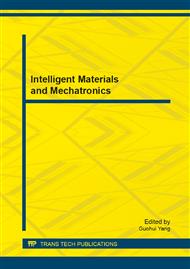[1]
Z. Zhemg, D. Feldman, Synthetic fibre-reinforced concrete, Journal Progress in polymer science, volume 20, Issue 2, 1995, pp.185-210.
Google Scholar
[2]
R. Brown, A. Shukla, K.R. Natarajan, Fibre reinforcement of concrete structures, University of Rhode Island transportation centre, September (2002).
Google Scholar
[3]
LI Bei-Xing, The mechanical properties of polypropylene fibre reinforced concrete, Journal of Wuhan University of Technology – Mater, Sci. Ed., No. 19-3, 2004, pp.68-71.
DOI: 10.1007/bf02835065
Google Scholar
[4]
Hager, I. Tracz, T. Influence of elevated temperature on selected properties of high performance concrete modified with the addition of polypropylene fibres , CEMENT WAPNO BETON, Volume: 14 Issue: 1 Pages: 3-+ Published: JAN-FEB (2009).
Google Scholar
[5]
Pistol, K., Weise, F., Meng, B. Polypropylen-Fasern in Hochleistungsbetonen Wirkungsmechanismen im Brandfall, Beton- und Stahlbetonbau, Volume 107, Issue 7, pages 476–483, July (2012).
DOI: 10.1002/best.201200024
Google Scholar
[6]
Zeiml, M; Leithner, D Lackner, R ; Mang, HA , How do polypropylene fibers improve the spalling behavior of in-situ concrete? CEMENT AND CONCRETE RESEARCH Volume: 36 Issue: 5 Pages: 929-942 Published: MAY (2006).
DOI: 10.1016/j.cemconres.2005.12.018
Google Scholar
[7]
S. SINGH, A. SHUKLA, R. BROWN, Pullout behaviour of polypropylene fibres from cementitious matrix, Journal Cement and Concrete Research, volume 34, 2004, p.1919–(1925).
DOI: 10.1016/j.cemconres.2004.02.014
Google Scholar
[8]
http: /ec. europa. eu/environment/chemicals/reach/reach_intro. htm [20. 12. 2010].
Google Scholar
[9]
Q.F. Wei, Surface characterization of plasma-treated polypropylene fibres. Journal of Materials Characterization, volume 52, 2004, p.231– 235.
DOI: 10.1016/j.matchar.2004.05.003
Google Scholar
[10]
P. Slepička, Argon plasma irradiation of polypropylene, Journal Nuclear Instruments and Methods in Physics Research B, Volume 268, Issues 11-12, June 2010, pp.2111-2114.
DOI: 10.1016/j.nimb.2010.02.012
Google Scholar
[11]
B. Felekoglu, K. Tosun, B. Baradan, A comparative study on the flexural performance of plasma treated polypropylene fibre reinforced cementitious composites, Journal of Materials Processing Technology, volume 209, 2009, p.5133–5144.
DOI: 10.1016/j.jmatprotec.2009.02.015
Google Scholar
[12]
C. Zhang, V.S. Gopalaratnam, H. K. Yasuda, Plasma treatment of polymeric fibres for improved performance in cement matrices. Journal of Applied Polymer Science, Volume 76, 2000, p.1985–(1996).
DOI: 10.1002/(sici)1097-4628(20000628)76:14<1985::aid-app1>3.0.co;2-g
Google Scholar
[13]
M. Simor,J. Rahel,P. Vojtek, et al., Atmospheric-pressure diffuse coplanar surface discharge for surface treatments, APPLIED PHYSICS LETTERS 81 (15), OCT 7 2002, pp.2716-2718.
DOI: 10.1063/1.1513185
Google Scholar
[14]
M. Černák, L. Černáková, I. Hudec, D. Kováčik, A. Zahoranová, Diffuse Coplanar Surface Barrier Discharge and its applications for in-line processing of low-added-value materials, The European Physical Journal Applied Physics 47, 2009, pp.1-6.
DOI: 10.1051/epjap/2009131
Google Scholar
[15]
M. Černák, Method and apparatus for treatment of textile materials, European patent No. 1 387 901 (received 31. 10. 2007).
Google Scholar
[16]
M. Černák, Application and equipment for treatment of textile materials, Czech patent No. 300 574 (received 2009).
Google Scholar
[17]
M. Černák, J. Ráhel, Apparatus and treatment method of wood surfaces, wood fibres and wooden, WO2008085139 (patent pending).
Google Scholar
[18]
www. pegas. cz.
Google Scholar
[19]
Kopkáně, D.; Bodnárová, L.; Hela, R.; Petránek, V.; Sťahel, P.; Černák, M. Diffuse coplanar surface barrier discharge for enhance cohesion of polypropylene fibers. in 2nd wta- international phd symposium. WTA Publications, 2011. s. 336-343. ISBN: 978-3-937066-21- 9.
Google Scholar
[20]
Skácelová, D.; Fialová, M.; Sťahel, P.; Černák, M.: Improvement of surface properties of reinforcing polypropylene fibres by atmospheric pressure plasma treatment. In 30th ICPIG Conference Proceedings. Belfast, UK : Queen's University Belfast, 2011. nestránkováno, -3 s. 30. 8. 2011, Belfast, UK.
Google Scholar
[21]
Fialová, M.; Skácelová, D.; Sťahel, P.; Černák, M.: Improvement of wetting properties of polypropylene fibres by atmospheric pressure plasma treatment. In Book of Extended abstracts, PASNPG 2011. Blansko : 2011. s. 25-26. 17. 10. 2011, Blansko.
Google Scholar
[22]
Fialová, M.; Skácelová, D.; Sťahel, P.; Černák, M.: Reinforcing polypropylene fibres modified by atmospheric pressure plasma. 2011. ISBN 978-80-87294-23-9.
Google Scholar


